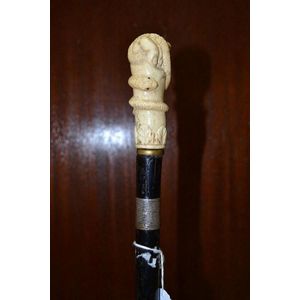Ivory Fist and Snake Walking Stick
You must be a subscriber, and be logged in to view price and dealer details.
Subscribe Now to view actual auction price for this item
When you subscribe, you have the option of setting the currency in which to display prices to $Au, $US, $NZ or Stg.
- Ivory - Ivory is a hard white material that comes from the tusks of elephants, mammoth, walrus and boar, or from the teeth of hippopotamus and whales. The ivory from the African elephant is the most prized source of ivory. Although the mammoth is extinct, tusks are still being unearthed in Russia and offered for sale.
Ivory has been used since the earliest times as a material for sculpture of small items, both in Europe and the east, principally China and Japan.
In Asia ivory has been carved for netsuke, seals, okimono, card cases, fan supports, animals and other figures and even as carved tusks.
In the last 200 years in Europe ivory has been used to carve figures, for elaborate tankards, snuff boxes, cane handles, embroidery and sewing accessories, in jewellery and as inlay on furniture. Its more practical uses include being used for billiard balls, buttons, and a veneers on the top of piano keys.
The use and trade of elephant ivory have become controversial because they have contributed to Due to the decline in elephant populations because of the trade in ivory, the Asian elephant was placed on Appendix One of the Convention on International Trade in Endangered Species (CITES), in 1975, and in January 1990, the African elephant was similarly listed. Under Appendix One, international trade in Asian or African elephant ivory between member countries is forbidden. Unlike trade in elephant tusks, trade in mammoth tusks is legal.
Since the invention of plastics, there have been many attempts to create an artificial ivory
This item has been included into following indexes:
-
walking sticks and canes, material
- ivory or ivory mounted 209
- silver mounted 435
Visually similar items

A rewarewa walking stick, the shaft terminating in a moulded ivorine handle decorated with theatre curtains and the Greek comedy masks, metal ferrule to the tip. Length 88 cm. Provenance: The Flower Family Collection.

A carved hardwood walking stick, New Zealand timbers, late 19th century, 97 cm

19th century carved ivory puzzle ball on stand, the puzzle ball decorated with dragons

A rare Tibetan parcel- gilt silver-inlaid wrought- iron Phurba, circa 16th century, the central Vajra with slightly moveable prongs, the top with a gilt three-headed wrathful deity crowned with skulls, the blade with a three dimensional gilt Makara and sli
